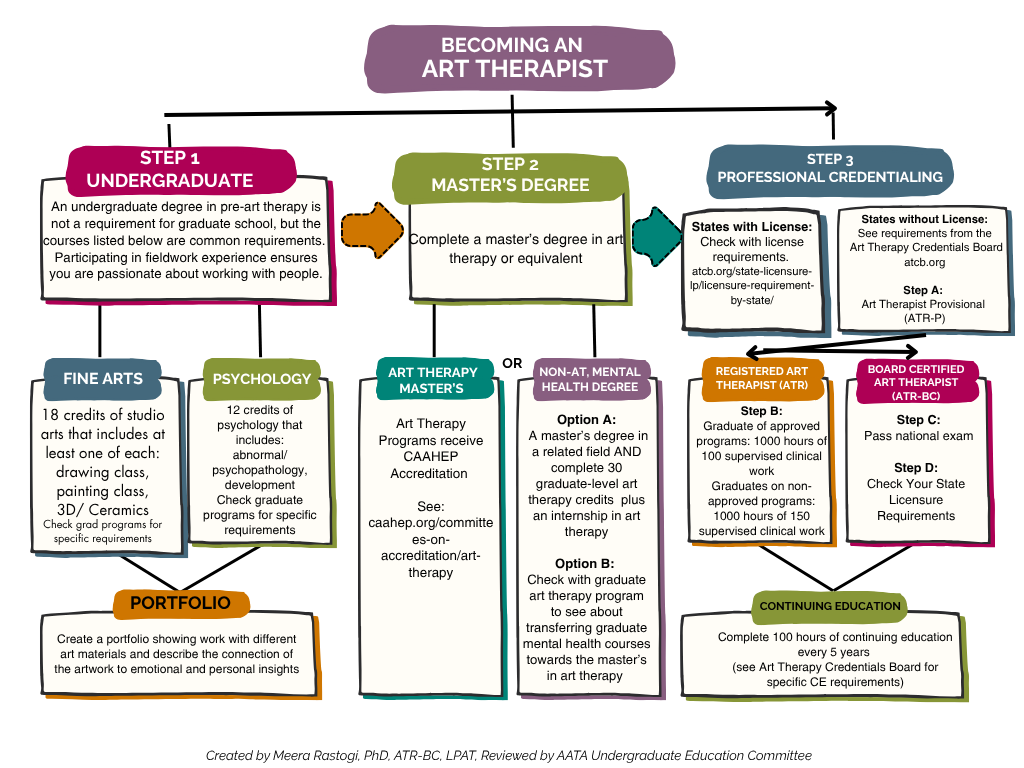BECOMING AN ART THERAPIST
Art therapists are clinicians with master’s-level or higher degrees trained in art and therapy that serve communities in different settings. Guided by ethical standards and scope of practice, their education and supervised training prepares them for culturally proficient work with diverse populations.
;. Th.
Everyday, art therapists support their clients’ mental, emotional, and physical well-being, including children experiencing behavioral challenges, such as Autism Spectrum Disorder; people and caregivers in medical crises; victims of violence or other trauma—from military servicemembers to student survivors of mass shootings; older adults struggling with dementia or Alzheimer’s Disease; or anyone that needs help coping with life’s challenges.


WHAT KIND OF EDUCATION DO I NEED TO BECOME AN ART THERAPIST?
A master’s degree is necessary for entry-level practice in art therapy. The educational standards require graduate level coursework that includes training in:
- the creative process,
- psychological development,
- group therapy,
- art therapy assessment,
- psychodiagnostics,
- research methods, and
- multicultural competency development and cultural humility.
Students must also complete, at minimum, 100 hours of supervised practicum, and 600 hours of supervised art therapy clinical internship. In addition, preparatory training at a prerequisite level in studio art methods in a variety of two- and three-dimensional art media and processes are required. (For example, drawing, painting, digital art, clay or sculpture; although not all of these examples are included for program applications so check with any program to which you may apply.)
In addition, foundational areas of study in psychology are also required in advance of graduate studies. Most graduate programs require at least a prerequisite course in some sort of developmental psychology and also abnormal psychology. The art therapy graduate curriculum is uniquely guided by the premise that focused art-making constitutes reflective practice and facilitates learning.
WHERE CAN I FIND A MASTER’S LEVEL ART THERAPY PROGRAM WHERE I LIVE?
There are master’s level art therapy programs located across the United States and Canada. Please review the Selecting a Master’s Program link from our website to find program options. Program designs include fully in-person, hybrid/low residency, or fully online. .
HOW DO I KNOW IF AN EDUCATION PROGRAM IS A QUALITY PROGRAM?
High quality art therapy programs prepare their students for entry level skills and post-graduate board certification as an art therapist. Quality programs also undergo a rigorous annual review process which ensures their resources, curriculum, faculty and policies are prepared to meet your learning needs. Educational standards are managed by the Accreditation Council for Art Therapy Education (ACATE), which is overseen by the Commission on the Accreditation of Allied Health Education programs (CAAHEP).
WILL MY EDUCATIONAL PROGRAM PREPARE ME TO BECOME A BOARD-CERTIFIED ART THERAPIST?
The American Art Therapy Association (AATA) encourages you to consider an CAAHEP-accredited program. These programs undergo a rigorous review process, which ensures their resources, curriculum, faculty, and policies will meet your learning needs and prepare you for future board certification.
WHAT SHOULD I EXPECT FROM AN EDUCATIONAL PROGRAM IN ORDER TO PURSUE AN ART THERAPY CAREER OR BECOME A BOARD-CERTIFIED ART THERAPIST?
Accredited art therapy masters programs ensure their resources, curriculum, faculty, and policies will prepare you for a career as a registered art therapist (ATR).
Art therapy has historically been referred to as an integrative profession with coursework from what is known as related mental health professions being combined with coursework taught by board-certified art therapists and which focuses on art therapy theories and methods. National education standards detail resources, processes, and curriculum requirements for accredited programs and provide an outline of content for courses. Learn more.
In addition, graduate programs pay attention to curriculum content requirements delineated by the Art Therapy Credentials Board (ATCB) and also from state licensing boards. While each art therapy program has its own unique coursework that highlights the expertise of its faculty or needs of the region it is located in, these content areas reflect the types of coursework typically in a graduate degree in art therapy:
- Psychopathology
- Psychological assessment
- Human growth and development
- Counseling/Psychological theories
- Helping relationships
- Research
- Professional orientation
- Ethical and legal issues
- Multicultural and social issues
- History and theory of art therapy
- Materials and techniques of practice in art therapy
- Creativity studies
- Studio art
- Application of art therapy with people in different treatment settings
- Art therapy assessment
- Group art therapy
- Culminating thesis or project
- Practicum and internship
Programs may also have coursework that highlights family therapy studies; trauma studies; studies in addiction; studies in related creative arts therapies such as drama therapy or dance-movement therapy; vocational and career development; additional studio electives, or medical art therapy. Note these are content areas, not course titles. Please see this FAQ to learn more.
WHAT OTHER ACTIVITIES DO THE GRADUATE CLASSES INCLUDE? HOW MUCH ART-MAKING IS INVOLVED?
Art therapy is a field grounded in research-based science that combines active art-making, the creative process, applied psychological theory, and the human experience within a psychotherapeutic relationship. To that end, graduate students of art therapy are scholar-practitioners that read scholarly material, write in both academic and journalling styles, and also explore art-making to foster reflective practice and to facilitate learning. Learn more in the scholarly journal, Art Therapy: Journal of the American Art Therapy Association..In
ARE THERE ANY UNDERGRADUATE DEGREES IN ART THERAPY?
A variety of colleges across the country do offer undergraduate coursework or majors in art therapy, as pre-professional information. It is important to know that undergraduate coursework or a major in art therapy is not required to apply to graduate art therapy programs, though such coursework at this pre-professional level can increase your confidence and provide a strong foundation for future studies. In addition, the courses offer an opportunity to further explore the career and whether it is a fit for you! A list of a few resources for undergraduate pre-professional studies is available here, though please note this is not an exhaustive list. (Inclusion of a college on this list is not indicative of an endorsement by AATA, but is offered for information purposes.)
ARE THERE ANY DOCTORAL PROGRAMS IN ART THERAPY?
Yes, and a list of available doctoral programs may be viewed here. (Inclusion of a doctoral program on this list is not indicative of an endorsement by AATA, but is offered for information purposes.)
WHAT DO I NEED TO COMPLETE AFTER I GRADUATE?
Individuals who graduate with their master’s degree in art therapy can pursue further national credentialing and licensure (depending on the state of practice). Visit our Credentialing and Licensure page to review the requirements for each, and the differences between the two.
